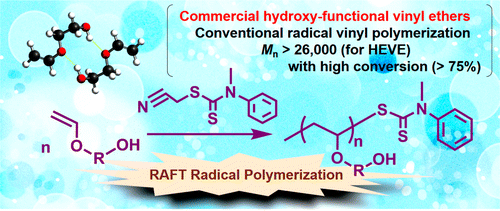当前位置:
X-MOL 学术
›
Macromolecules
›
论文详情
Our official English website, www.x-mol.net, welcomes your
feedback! (Note: you will need to create a separate account there.)
Direct Radical Polymerization of Vinyl Ethers: Reversible Addition–Fragmentation Chain Transfer Polymerization of Hydroxy-Functional Vinyl Ethers
Macromolecules ( IF 5.1 ) Pub Date : 2016-02-19 00:00:00 , DOI: 10.1021/acs.macromol.6b00145 Shinji Sugihara 1, 2 , Yuki Kawamoto 1 , Yasushi Maeda 1
Macromolecules ( IF 5.1 ) Pub Date : 2016-02-19 00:00:00 , DOI: 10.1021/acs.macromol.6b00145 Shinji Sugihara 1, 2 , Yuki Kawamoto 1 , Yasushi Maeda 1
Affiliation

|
Unprecedented controlled radical vinyl polymerization (CRP) of vinyl ethers using reversible addition–fragmentation chain transfer (RAFT) polymerization is reported. In order to overcome the challenge of direct radical polymerization of vinyl ethers, commercial hydroxy-functional vinyl ethers such as 2-hydroxyethyl vinyl ether (HEVE) were subjected to free radical polymerization, generating vinyl polymers without polyacetals obtained by self-polyaddition polymerization. In the case of bulk polymerization using a nonacidic azo-initiator such as dimethyl 2,2′-azobis(2-methylpropionate), conventional free radical vinyl polymerization occurred with sufficiently high number-average molecular weight. For example, poly(HEVE) was produced from the corresponding HEVE monomer with Mn = 26 400 in high yield, ≥75%. The resulting polymer was nearly identical to the polymer prepared by living cationic polymerization using the protected monomers except for the steric regularity (meso dyads are 51% and 67% for radical and cationic polymerizations, respectively). Furthermore, cyanomethyl methyl(phenyl)carbamodithioate was found to be an efficient RAFT agent, enabling the CRP of hydroxy-functional vinyl ethers. Under the polymerization conditions, poly(HEVE) macromolecular chain transfer agent (macro-CTA) was prepared. The kinetic studies of RAFT polymerization showed a linear increase of the molecular weight, with up to 50% monomer conversion and relatively low polydispersities (Mw/Mn < 1.38). In addition, chain extension experiments including block copolymerization with vinyl acetate and N-vinylpyrrolidone were demonstrated using the resulting poly(HEVE) macro-CTA to confirm the “livingness” of the poly(HEVE).
中文翻译:

乙烯基醚的直接自由基聚合:羟基官能乙烯基醚的可逆加成-断裂链转移聚合
据报道,使用可逆的加成-断裂链转移(RAFT)聚合技术实现了前所未有的乙烯基醚的受控自由基乙烯基聚合反应(CRP)。为了克服乙烯基醚的直接自由基聚合的挑战,对诸如2-羟乙基乙烯基醚(HEVE)之类的商业羟基官能乙烯基醚进行自由基聚合,以产生不具有通过自聚加成聚合获得的聚缩醛的乙烯基聚合物。在使用非酸性偶氮引发剂如2,2'-二甲基二甲基二甲酸酯(2-甲基丙酸酯)的本体聚合的情况下,发生了常规的自由基乙烯基聚合,其具有足够高的数均分子量。例如,由相应的具有M n的HEVE单体生产聚(HEVE)= 26400的高产率,≥75%。所得聚合物几乎与通过使用受保护的单体的活性阳离子聚合制备的聚合物相同,除了空间规则性(对于自由基聚合和阳离子聚合,内消旋二元组分别为51%和67%)。此外,发现氰基甲基(苯基)氨基甲酰二硫代甲基丙烯酸酯是有效的RAFT剂,使得能够对羟基官能的乙烯基醚进行CRP。在聚合条件下,制备了聚(HEVE)大分子链转移剂(macro-CTA)。RAFT聚合的动力学研究表明分子量线性增加,单体转化率高达50%,且多分散性相对较低(M w / M n<1.38)。另外,使用所得的聚(HEVE)大分子CTA证实了扩链实验,包括与乙酸乙烯酯和N-乙烯基吡咯烷酮的嵌段共聚,以证实聚(HEVE)的“活性”。
更新日期:2016-02-19
中文翻译:

乙烯基醚的直接自由基聚合:羟基官能乙烯基醚的可逆加成-断裂链转移聚合
据报道,使用可逆的加成-断裂链转移(RAFT)聚合技术实现了前所未有的乙烯基醚的受控自由基乙烯基聚合反应(CRP)。为了克服乙烯基醚的直接自由基聚合的挑战,对诸如2-羟乙基乙烯基醚(HEVE)之类的商业羟基官能乙烯基醚进行自由基聚合,以产生不具有通过自聚加成聚合获得的聚缩醛的乙烯基聚合物。在使用非酸性偶氮引发剂如2,2'-二甲基二甲基二甲酸酯(2-甲基丙酸酯)的本体聚合的情况下,发生了常规的自由基乙烯基聚合,其具有足够高的数均分子量。例如,由相应的具有M n的HEVE单体生产聚(HEVE)= 26400的高产率,≥75%。所得聚合物几乎与通过使用受保护的单体的活性阳离子聚合制备的聚合物相同,除了空间规则性(对于自由基聚合和阳离子聚合,内消旋二元组分别为51%和67%)。此外,发现氰基甲基(苯基)氨基甲酰二硫代甲基丙烯酸酯是有效的RAFT剂,使得能够对羟基官能的乙烯基醚进行CRP。在聚合条件下,制备了聚(HEVE)大分子链转移剂(macro-CTA)。RAFT聚合的动力学研究表明分子量线性增加,单体转化率高达50%,且多分散性相对较低(M w / M n<1.38)。另外,使用所得的聚(HEVE)大分子CTA证实了扩链实验,包括与乙酸乙烯酯和N-乙烯基吡咯烷酮的嵌段共聚,以证实聚(HEVE)的“活性”。




















































 京公网安备 11010802027423号
京公网安备 11010802027423号